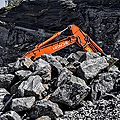ROCK CRUSHING METHOD AND SEPARATING GOLD FROM ORES
October 13, 2017
Rock crushing methods occupy entire chapters in mining textbooks. Known colloquially as ‘Comminution,’ the rock chewing science describes a series of dynamic engineering procedures, with crushing jaws acting as the core of this equipment group. They’re the primary line, the most robust, alloy-reinforced gear in the whole mining complex. Watch as comminution technology breaks down a bank of unwieldy rocks, as the crushing equipment spits out a stream of transportable solids.
Rock Crushing Science
This is an engineering discipline, not a random smash-and-grab process. Engineered for maximum productivity, the crushing surfaces intelligently split and compress the rock so that all size-reduction goals are met. Picture a compressive mechanism, a funnel or cone-shaped crusher. The metal housing and all of its moving parts are rated to handle immense compressive stresses, plus the accompanying abrasive forces. Now, as the rocky stream feeds down through the cone, the angled metal planes crush the rocks. Deeper inside that angularly locked feed mechanism, the rocks shear and abrade, then they slip through the smaller discharge outlet as a transport-friendly surge.
Delivering Size Reduction Diversity
In a crunch, apologies for the pun, the rocks can be looped back through the primary crusher again or passed towards a secondary crushing station. As for the types of crushers in use here, there’s the funnel or cone variant covered above. Then there are grizzly scalping units, machines that use evenly spaced bars to filter the oversize. But what about the actual rock masticating innards? How do they operate? Built to absorb massive impacts and material-tearing abrasive shocks, only the toughest alloys can persevere here. They’re the compressive rollers and gyratory crushers, plus the traditional hammering jaws that really augment the rock-reduction procedure.
After The Workhorse Crushing Line
Just as an example of the machine versatility powering away inside a mine, let’s check out a separation method that takes place after the crushers. Gold ore separation uses comminution techniques to break down the excavated rock, but the material hardly looks like a lustrous yellow-orange metal. In order to properly free this rich element from the rock, the crushing stage has to be followed by a chemically active stage, such as the cyanidation process or the carbon in pulp release method. These reagents chemically separate the gold from the ore, so they’re every bit as essential to a mine’s operations as any primary crushing equipment.
Today, we’ve learned that different forces are described when we talk about rock crushing methods in mines. They compress, abrade, and shear the ore. Finally, those different crushing surfaces, at least in the case of the hypothetical gold mine just mentioned, produce small but still unrecognizable ore streams. It takes a chemical reagent or heat to finally release the pure element from its compound form.
Optimized by: Netwizard SEO
